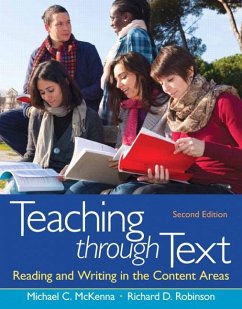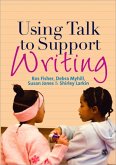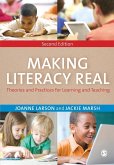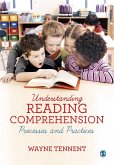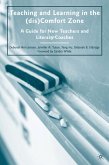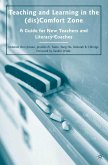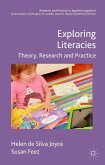Pre-service and in-serv Product Description
Pre-service and in-service middle and secondary school teachers get a core set of instructional techniques in this evidence-based, practical resource designed to help them incorporate reading-related approaches into their classroom. The approaches are easy to follow, practical, effective, feature a strong empirical base and reflect the latest thinking in the field.
Features + Benefits
The approaches are easy to follow, practical, effective, feature a strong empirical base, andreflect the latest thinking in the field.
Teachers benefit from the straightforward organization that presents the approaches in a "before-during-after" lesson format.
Teachers get additional free resources they can turn to through the book's "Net Worth" boxes that provide up-to-date Web sites.
Additional ideas for extending the approaches and concepts are provided in "Getting Involved" sections, packed with activities and assignments.
Backcover
Pre-service and in-service middle and secondary school teachers get a core set of instructional techniques in this evidence-based, practical resource designed to help them incorporate reading-related approaches into their content classroom. The approaches are easy to follow, practical, effective, feature a strong empirical base and reflect the latest thinking in the field.
This new edition is an even more valuable resource for learning about content literacy through its up-to-date technology, emphasis on teaching literacy skills to second language learners, practical approach to applying concepts and techniques in actual classrooms, many expanded discussions, new examples, and much more.
Included are additional writing applications and web resources, new examples making the important concepts refreshingly clear, updated references, a series of 13 podcasts available online introducing the content of each chapter, and much more.
Also from authors Michael D. McKenna & Richard D. Robinson:
0132316412 - Issues and Trends in Literacy Education, 5/e - c2012
Preface
Section 1: Teaching and Learning through Text
1 The Importance of Literacy in Content Areas
Objectives
The Meaning of Literacy
Four Aspects of Literacy
The Implications of Content Literacy
Disciplinary Literacy
Teacher Resistance to Content Literacy
Content Literacy and the Common Core Standards
Seeing Yourself as a Teacher
Summary
Getting Involved
2 Literacy Processes
Objectives
Reading and Writing as Language Processes
The Reading Process
The Writing Process
Making Sense Out of Content
Summary
Getting Involved
3 Getting to Know Your Students, Your Materials, and Your Teaching
Objectives
Three Dimensions of Classroom Assessment
What Is Reading Ability?
Levels of Reading Ability
Reading Ability and Readability
Judging the Match Between Students and Materials
Judging the Context of Instruction
Three Struggling Readers
Summary
Getting Involved
4 Teaching for Diversity
Objectives
Dimensions of Diversity
Meeting the Challenge of Diversity
Summary
Getting Involved
Section 2: Prereading Strategies
5 Building Prior Knowledge
Objectives
Judging Whether Prior Knowledge Is Adequate
Ways to Add and Activate Background Knowledge
Summary
Getting Involved
6 Introducing Technical Vocabulary
Objectives
The Nature of Words
The Myth That Words Teach Themselves
Formal Definitions
Feature Analysis
Graphic Organizers
Additional Methods
Summary
Getting Involved
Section 3: Strategies for Guided Reading
7 Making Reading Purposeful
Objectives
Who Should Set Purposes for Reading?
Ways of Setting Purposes
Varying and Combining Techniques
Summary
Getting Involved
8 Reading Guides
Objectives
Advantages of a Written Guide
When Should Reading Guides Be Used?
Types of Guides
Constructing a Reading Guide
Computerizing Reading Guides and Units
Using Reading Guides
Summary
Getting Involved
9 Providing Time to Read: When, Where, and How?
Objectives
Reading Assignments as Homework
Structuring Units to Allow Reading in Class
Major Lesson Formats
Summary
Getting Involved
Section 4: Postreading Strategies
10 Questioning and Discussion
Objectives
The Purposes of Discussion
Planning a Discussion
Conducting a Discussion
Alternatives to Teacher-Led Discussions
Discussion and Recitation: A Second Look
Discussion and Writing
Summary
Getting Involved
11 Reinforcing and Extending Content Knowledge
Objectives
Drilling versus Extending
Using Literacy to Reinforce and Extend
Reinforcing through Direct Instruction
Summary
Getting Involved
Section 5: More Ways to Facilitate Learning through Text
12 Study Skills: Encouraging Independence in Content Literacy
Objectives
Responsibility for Teaching Study Skills
Note Taking
Review and Homework
Test Taking
Pre-service and in-service middle and secondary school teachers get a core set of instructional techniques in this evidence-based, practical resource designed to help them incorporate reading-related approaches into their classroom. The approaches are easy to follow, practical, effective, feature a strong empirical base and reflect the latest thinking in the field.
Pre-service and in-service middle and secondary school teachers get a core set of instructional techniques in this evidence-based, practical resource designed to help them incorporate reading-related approaches into their classroom. The approaches are easy to follow, practical, effective, feature a strong empirical base and reflect the latest thinking in the field.
Features + Benefits
The approaches are easy to follow, practical, effective, feature a strong empirical base, andreflect the latest thinking in the field.
Teachers benefit from the straightforward organization that presents the approaches in a "before-during-after" lesson format.
Teachers get additional free resources they can turn to through the book's "Net Worth" boxes that provide up-to-date Web sites.
Additional ideas for extending the approaches and concepts are provided in "Getting Involved" sections, packed with activities and assignments.
Backcover
Pre-service and in-service middle and secondary school teachers get a core set of instructional techniques in this evidence-based, practical resource designed to help them incorporate reading-related approaches into their content classroom. The approaches are easy to follow, practical, effective, feature a strong empirical base and reflect the latest thinking in the field.
This new edition is an even more valuable resource for learning about content literacy through its up-to-date technology, emphasis on teaching literacy skills to second language learners, practical approach to applying concepts and techniques in actual classrooms, many expanded discussions, new examples, and much more.
Included are additional writing applications and web resources, new examples making the important concepts refreshingly clear, updated references, a series of 13 podcasts available online introducing the content of each chapter, and much more.
Also from authors Michael D. McKenna & Richard D. Robinson:
0132316412 - Issues and Trends in Literacy Education, 5/e - c2012
Preface
Section 1: Teaching and Learning through Text
1 The Importance of Literacy in Content Areas
Objectives
The Meaning of Literacy
Four Aspects of Literacy
The Implications of Content Literacy
Disciplinary Literacy
Teacher Resistance to Content Literacy
Content Literacy and the Common Core Standards
Seeing Yourself as a Teacher
Summary
Getting Involved
2 Literacy Processes
Objectives
Reading and Writing as Language Processes
The Reading Process
The Writing Process
Making Sense Out of Content
Summary
Getting Involved
3 Getting to Know Your Students, Your Materials, and Your Teaching
Objectives
Three Dimensions of Classroom Assessment
What Is Reading Ability?
Levels of Reading Ability
Reading Ability and Readability
Judging the Match Between Students and Materials
Judging the Context of Instruction
Three Struggling Readers
Summary
Getting Involved
4 Teaching for Diversity
Objectives
Dimensions of Diversity
Meeting the Challenge of Diversity
Summary
Getting Involved
Section 2: Prereading Strategies
5 Building Prior Knowledge
Objectives
Judging Whether Prior Knowledge Is Adequate
Ways to Add and Activate Background Knowledge
Summary
Getting Involved
6 Introducing Technical Vocabulary
Objectives
The Nature of Words
The Myth That Words Teach Themselves
Formal Definitions
Feature Analysis
Graphic Organizers
Additional Methods
Summary
Getting Involved
Section 3: Strategies for Guided Reading
7 Making Reading Purposeful
Objectives
Who Should Set Purposes for Reading?
Ways of Setting Purposes
Varying and Combining Techniques
Summary
Getting Involved
8 Reading Guides
Objectives
Advantages of a Written Guide
When Should Reading Guides Be Used?
Types of Guides
Constructing a Reading Guide
Computerizing Reading Guides and Units
Using Reading Guides
Summary
Getting Involved
9 Providing Time to Read: When, Where, and How?
Objectives
Reading Assignments as Homework
Structuring Units to Allow Reading in Class
Major Lesson Formats
Summary
Getting Involved
Section 4: Postreading Strategies
10 Questioning and Discussion
Objectives
The Purposes of Discussion
Planning a Discussion
Conducting a Discussion
Alternatives to Teacher-Led Discussions
Discussion and Recitation: A Second Look
Discussion and Writing
Summary
Getting Involved
11 Reinforcing and Extending Content Knowledge
Objectives
Drilling versus Extending
Using Literacy to Reinforce and Extend
Reinforcing through Direct Instruction
Summary
Getting Involved
Section 5: More Ways to Facilitate Learning through Text
12 Study Skills: Encouraging Independence in Content Literacy
Objectives
Responsibility for Teaching Study Skills
Note Taking
Review and Homework
Test Taking
Pre-service and in-service middle and secondary school teachers get a core set of instructional techniques in this evidence-based, practical resource designed to help them incorporate reading-related approaches into their classroom. The approaches are easy to follow, practical, effective, feature a strong empirical base and reflect the latest thinking in the field.

